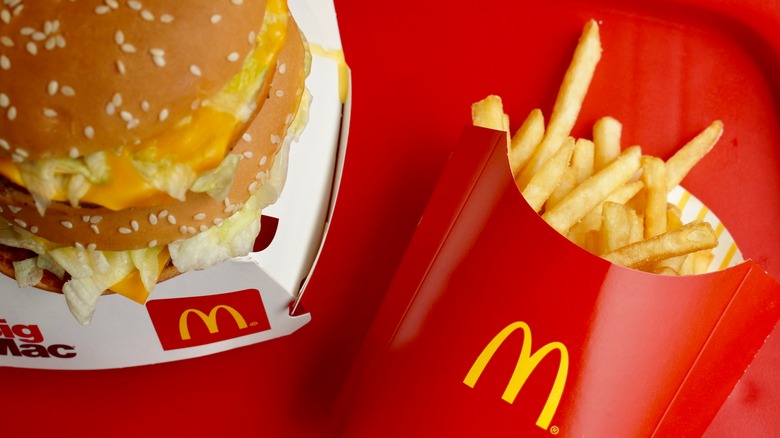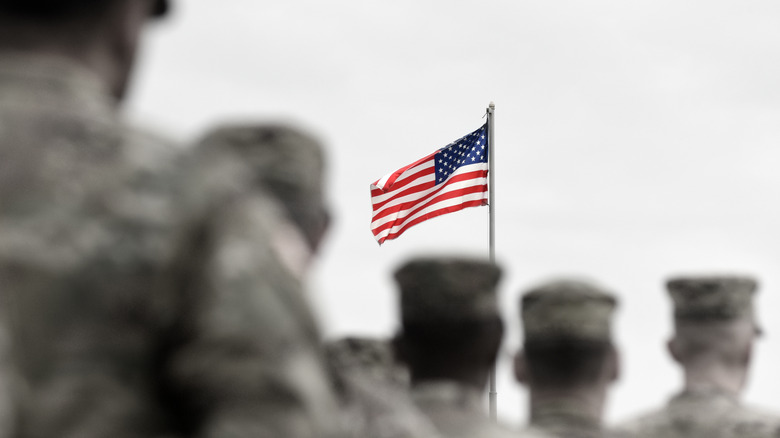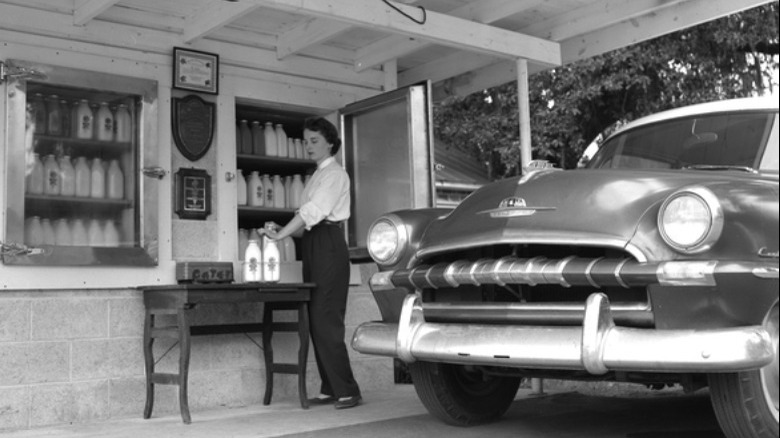How The Military Influenced McDonald's Decision To Open A Drive-Thru
It would be quite a funny sight, and also perhaps terrifying: A giant, honking tank rolls up to a Mickey D's drive-thru speaker, you hear a metal latch pop, a dude sticks his head out of the tank, yells for enough Big Macs for the crew, and the tank does not blow the whole restaurant to hell. That'll be zero dollars. You're in a tank.
Well, McLovers round the world, take heart. The next time you go McTruckin' through a McDonald's drive-thru on the hunt for your kid's final piece of indispensable Happy Meal merchandising, know that you're in the company of some of the fittest, toughest, most well-trained gun users and order-takers in existence: the U.S. military. Specifically, you're on board with the Army back in Fort Huachuca in Sierra Vista, Arizona, circa 1975.
Back then, soldiers weren't allowed to be seen out and about in public in their "olive-drab fatigues," as We Are the Mighty explains. There was a longstanding rule about military decorum that made it impossible, as AZ Central cites Steve Gregory, technician at the Fort Huachuca Museum. And yet, only about two miles down the road from Fort Huachuca stood the Golden Arches. David Rich, the owner of that McDonald's, had a vision that would forever fuse the most critical elements of Americana: military chutzpa, too much cholesterol, and an unwillingness to leave your car.
The freedom to stay seated
The stage, or rather car-window-high booth, had been set for drive-thrus decades before Fort Huachuca in Sierra Vista, Arizona in 1975. In the early 20th century, cities weren't like what they are today: cross-hatches of car lanes broken apart by the occasional block of buildings. The law, and common custom, was on the side of all the pedestrians getting hit and maimed by the new, metal, technological terror of the urban landscape, as Scientific American explains. The car industry pushed back, especially through the American Automobile Association (AAA), which supplied road safety curricula to schools. As a result, the amount of cars per 1,000 people jumped from 87 to 324 from 1920 to 1950, as the U.S. Department of Energy shows. By 1975, that number was up to 640.
In other words, McDonald's would have opened a drive-thru sooner or later; David Rich just got to it first. The year prior in 1974, a different franchise owner in Dallas got approval for a pretty ambitious drive-thru concept: a garden-themed, four-columned portico full of McDonald's characters, including a life-sized Ronald McDonald statue to receive orders, as AZ Central explains. David Rich took the more practical route to accommodate some of his best customers — the Army — as quickly as possible. He pushed out a portion of the wall with just enough standing room for an attendant, and installed a sliding window. Voila: Instant childhood memories for the car-bound for decades to come.
A long, sedentary history
Even though we have the US Army to thank for the first McDonald's drive-thru, McDonald's was surprisingly late to the drive-thru party. Banks go there first in the 1930s, as AZ Central explains, when sedentary pioneer Jordan Martin cut drive-thrus directly through buildings. The first burger-centric drive-thru came in 1947 when Sheldon "Red" Chaney built a drive-thru at his shop, Red's Hamburg, along a road that perfectly embodies America's "freedom of the road" mythos: Route 66 in Springfield, Montana. In-and-Out joined the club in 1948 with the first intercom-based drive-thru.
Over the next 20 years various food and drink establishments, mostly smaller and independent, tried their hand at drive-thrus. McDonald's and other chains didn't take the trend seriously, and instead followed different customer demands. Hamburger joints were connected to American counterculture from the 1950s through '70s, and most folks took their food with them and hung out outside on a bench, a curb, just standing, etc. People seemed more interested in staying in the restaurant and eating rather than chowing down in their Buicks, Fords, what-have-you. And so, McDonald's took to overhauling their interiors first, down to the white-and-red tiled floor pattern that stands to this day.
Surprisingly, it took until 1983 for cup-holders to be invented, when they were first installed in a new type of vehicle: the minivan (via the Society Pages).


